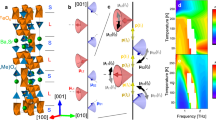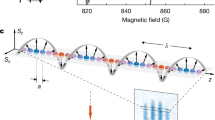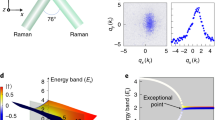Abstract
Spin–orbit coupling links a particle’s velocity to its quantum-mechanical spin, and is essential in numerous condensed matter phenomena, including topological insulators and Majorana fermions. In solid-state materials, spin–orbit coupling originates from the movement of electrons in a crystal’s intrinsic electric field, which is uniquely prescribed in any given material. In contrast, for ultracold atomic systems, the engineered ‘material parameters’ are tunable: a variety of synthetic spin–orbit couplings can be engineered on demand using laser fields. Here we outline the current experimental and theoretical status of spin–orbit coupling in ultracold atomic systems, discussing unique features that enable physics impossible in any other known setting.
This is a preview of subscription content, access via your institution
Access options
Subscribe to this journal
Receive 51 print issues and online access
$199.00 per year
only $3.90 per issue
Buy this article
- Purchase on Springer Link
- Instant access to full article PDF
Prices may be subject to local taxes which are calculated during checkout



Similar content being viewed by others
References
Balents, L. Spin liquids in frustrated magnets. Nature 464, 199–208 (2010)
Hasan, M. Z. & Kane, C. L. Topological insulators. Rev. Mod. Phys. 82, 3045–3067 (2010)
von Klitzing, K., Dorda, G. & Pepper, M. New method for high-accuracy determination of the fine-structure constant based on quantized Hall resistance. Phys. Rev. Lett. 45, 494–497 (1980)
Tsui, D. C., Stormer, H. L. & Gossard, A. C. Two-dimensional magnetotransport in the extreme quantum limit. Phys. Rev. Lett. 48, 1559–1562 (1982)
Bloch, I., Dalibard, J. & Zwerger, W. Many-body physics with ultracold gases. Rev. Mod. Phys. 80, 885–964 (2008)
Osterloh, K., Baig, M., Santos, L., Zoller, P. & Lewenstein, M. Cold atoms in non-abelian gauge potentials: from the Hofstadter “Moth” to lattice gauge theory. Phys. Rev. Lett. 95, 010403 (2005)This paper was an initial proposal suggesting a method of creating SOC in cold atoms (equivalent to a non-Abelian gauge field), in a lattice potential.
Ruseckas, J., Juzeliūnas, G., Ohberg, P. & Fleischhauer, M. Non-abelian gauge potentials for ultracold atoms with degenerate dark states. Phys. Rev. Lett. 95, 010404 (2005)This paper was an initial proposal suggesting a method of creating SOC in cold atoms (equivalent to a non-Abelian gauge field) in the continuum.
Liu, X.-J., Borunda, M. F., Liu, X. & Sinova, J. Effect of induced spin–orbit coupling for atoms via laser fields. Phys. Rev. Lett. 102, 046402 (2009)
Juzeliūnas, G., Ruseckas, J. & Dalibard, J. Generalized Rashba-Dresselhaus spin–orbit coupling for cold atoms. Phys. Rev. A 81, 053403 (2010)
Anderson, B. M., Juzeliūnas, G., Galitski, V. M. & Spielman, I. B. Synthetic 3D spin–orbit coupling. Phys. Rev. Lett. 108, 235301 (2012)
Lin, Y.-J., Compton, R. L., Jiménez-García, K., Porto, J. V. & Spielman, I. B. Synthetic magnetic fields for ultracold neutral atoms. Nature 462, 628–632 (2009)
Lin, Y.-J., Jiménez-García, K. & Spielman, I. B. Spin-orbit-coupled Bose–Einstein condensates. Nature 471, 83–86 (2011)This work demonstrated the first observation of SOC in an atomic quantum gas, and observed a quantum phase transition in the resulting two-component spin–orbit-coupled BECs.
Sau, J. D., Lutchyn, R. M., Tewari, S. & Das Sarma, S. Generic new platform for topological quantum computation using semiconductor heterostructures. Phys. Rev. Lett. 104, (2010)
Fisher, M. P. A., Weichman, P. B., Grinstein, G. & Fisher, D. S. Boson localization and the superfluid-insulator transition. Phys. Rev. B 40, 546–570 (1989)
Greiner, M., Mandel, O., Esslinger, T., Hansch, T. W. & Bloch, I. Quantum phase transition from a superfluid to a Mott insulator in a gas of ultracold atoms. Nature 415, 39–44 (2002)
Radić, J., Di Ciolo, A., Sun, K. & Galitski, V. Exotic quantum spin models in spin–orbit-coupled Mott insulators. Phys. Rev. Lett. 109, 085303 (2012)
Cole, W., Zhang, S., Paramekanti, A. & Trivedi, N. Bose-Hubbard models with synthetic spin–orbit coupling: Mott insulators, spin textures, and superfluidity. Phys. Rev. Lett. 109, 085302 (2012)
Levin, M. & Stern, A. Fractional topological insulators. Phys. Rev. Lett. 103, 196803 (2009)
Sedrakyan, T. A., Kamenev, A. & Glazman, L. I. Composite fermion state of spin–orbit-coupled bosons. Phys. Rev. A 86, 063639 (2012)
Ashhab, S. & Leggett, A. J. Bose-Einstein condensation of spin-1/2 atoms with conserved total spin. Phys. Rev. A 68, 063612 (2003)
Cai, Z., Zhou, X. & Wu, C. Magnetic phases of bosons with synthetic spin–orbit coupling in optical lattices. Phys. Rev. A 85, 061605 (2012)
Stanescu, T., Anderson, B. & Galitski, V. Spin-orbit coupled Bose-Einstein condensates. Phys. Rev. A 78, 023616 (2008)
Bychkov, Y. A. & Rashba, E. I. Oscillatory effects and the magnetic susceptibility of carriers in inversion layers. J. Phys. Chem. 17, 6039–6045 (1984)
Meier, L. et al. Measurement of Rashba and Dresselhaus spin–orbit magnetic fields. Nature Phys. 3, 650–654 (2007)
Dresselhaus, G. Spin-orbit coupling effects in zinc blende structures. Phys. Rev. 100, 580–586 (1955)
von Zutic, I., Fabian, J. & Das Sarma, S. Spintronics: fundamentals and applications. Rev. Mod. Phys. 76, 323–410 (2004)
Sinova, J. et al. Universal intrinsic spin Hall effect. Phys. Rev. Lett. 92, 126603 (2004)
Kato, Y. K., Myers, R. C., Gossard, A. C. & Awschalom, D. D. Observation of the spin Hall effect in semiconductors. Science 306, 1910–1913 (2004)
Burkov, A. A. & Balents, L. Weyl semimetal in a topological insulator multilayer. Phys. Rev. Lett. 107, 127205 (2011)
Koralek, J. D. et al. Emergence of the persistent spin helix in semiconductor quantum wells. Nature 458, 610–613 (2009)
Kitaev, A. Y. Unpaired Majorana fermions in quantum wires. Phys.-Usp. 44, 131–136 (2001)This paper proposed that Majorana fermions can exist at the end of one-dimensional superconducting wires, an idea that is directly relevant to one-dimensional atomic Fermi gases with SOC.
Alicea, J., Oreg, Y., Refael, G., von Oppen, F. & Fisher, M. P. A. Non-Abelian statistics and topological quantum information processing in 1D wire networks. Nature Phys. 7, 412–417 (2011)
Mourik, V. et al. Signatures of Majorana fermions in hybrid superconductor-semiconductor nanowire devices. Science 336, 1003–1007 (2012)
Higbie, J. & Stamper-Kurn, D. M. Periodically dressed Bose-Einstein condensate: a superfluid with an anisotropic and variable critical velocity. Phys. Rev. Lett. 88, 090401 (2002)This paper proposed loading quantum degenerate gases into the laser-dressed states used in current SOC experiments.
Fu, Z., Wang, P., Chai, S., Huang, L. & Zhang, J. Bose-Einstein condensate in a light-induced vector gauge potential using 1064-nm optical-dipole-trap lasers. Phys. Rev. A 84, 043609 (2011)
Zhang, J.-Y. et al. Collective dipole oscillations of a spin–orbit coupled Bose-Einstein condensate. Phys. Rev. Lett. 109, 115301 (2012)
Wang, P. et al. Spin-orbit coupled degenerate Fermi gases. Phys. Rev. Lett. 109, 095301 (2012)This was the first observation of SOC in an atomic Fermi gas.
Cheuk, L. et al. Spin-injection spectroscopy of a spin–orbit coupled Fermi gas. Phys. Rev. Lett. 109, 095302 (2012)This paper describes the observation of SOC in an atomic Fermi gas, and a direct spectroscopic measurement of the SOC dispersion relation.
Campbell, D. L., Juzeliūnas, G. & Spielman, I. B. Realistic Rashba and Dresselhaus spin–orbit coupling for neutral atoms. Phys. Rev. A 84, 025602 (2011)
Wang, C., Gao, C., Jian, C.-M. & Zhai, H. Spin-orbit coupled spinor Bose-Einstein condensates. Phys. Rev. Lett. 105, 160403 (2010)
Ho, T.-L. & Zhang, S. Bose-Einstein condensates with spin–orbit interaction. Phys. Rev. Lett. 107, 150403 (2011)
Wu, C.-J., Mondragon-Shem, I. & Zhou, X.-F. Unconventional Bose–Einstein condensations from spin–orbit coupling. Chin. Phys. Lett. 28, 097102 (2011)
Giorgini, S., Pitaevskii, L. P. & Stringari, S. Theory of ultracold atomic Fermi gases. Rev. Mod. Phys. 80, 1215–1274 (2008)
Ketterle, W. & Zwierlein, M. W. Making, probing and understanding ultracold Fermi gases. In Proc. International School of Physics “Enrico Fermi”, Course CLXIV (Varenna, 20–30 June 2006) (eds Inguscio, M., Ketterle, W. & Salomon, C. ) 95–287 (IOS Press, 2008)
Chaplik, A. V. & Magarill, L. I. Bound states in a two-dimensional short range potential induced by the spin–orbit interaction. Phys. Rev. Lett. 96, 126402 (2006)
Gong, M., Tewari, S. & Zhang, C. BCS-BEC crossover and topological phase transition in 3D spin–orbit coupled degenerate Fermi gases. Phys. Rev. Lett. 107, 195303 (2011)
Yu, Z.-Q. & Zhai, H. Spin-orbit coupled Fermi gases across a Feshbach resonance. Phys. Rev. Lett. 107, 195305 (2011)
Veillette, M., Sheehy, D., Radzihovsky, L. & Gurarie, V. Superfluid transition in a rotating Fermi gas with resonant interactions. Phys. Rev. Lett. 97, 250401 (2006)
Levinsen, J., Cooper, N. R. & Gurarie, V. Strongly resonant p-wave superfluids. Phys. Rev. Lett. 99, 210402 (2007)
Regal, C. A., Ticknor, C., Bohn, J. L. & Jin, D. S. Tuning p-wave interactions in an ultracold Fermi gas of atoms. Phys. Rev. Lett. 90, 053201 (2003)
Williams, R. A. et al. Synthetic partial waves in ultracold atomic collisions. Science 335, 314–317 (2012)
Zhang, C., Tewari, S., Lutchyn, R. M. & Das Sarma, S. p x +ip y superfluid from s-wave interactions of fermionic cold atoms. Phys. Rev. Lett. 101, 160401 (2008)
Massignan, P., Sanpera, A. & Lewenstein, M. Creating p-wave superfluids and topological excitations in optical lattices. Phys. Rev. A 81, 031607 (2010)
Seo, K., Han, L. & Sá de Melo, C. Emergence of Majorana and Dirac particles in ultracold fermions via tunable interactions, spin–orbit effects, and Zeeman fields. Phys. Rev. Lett. 109, 105303 (2012)
Schnyder, A. P., Ryu, S., Furusaki, A. & Ludwig, A. W. W. Classification of topological insulators and superconductors in three spatial dimensions. Phys. Rev. B 78, 195125 (2008)
Kitaev, A. Periodic table for topological insulators and superconductors. AIP Conf. Proc. 1134, 22–30 (2009)
Moore, J. E. & Balents, L. Topological invariants of time-reversal-invariant band structures. Phys. Rev. B 75, 121306(R) (2007)
Gell-Mann, M. Symmetries of baryons and mesons. Phys. Rev. 125, 1067–1084 (1962)
Lindner, N. H., Refael, G. & Galitski, V. Floquet topological insulator in semiconductor quantum wells. Nature Phys. 7, 490–495 (2011)
Jiang, L. et al. Majorana fermions in equilibrium and driven cold atom quantum wires. Phys. Rev. Lett. 106, 220402 (2011)
Shapere, A. & Wilczek, F. Geometric Phases in Physics (World Pacific, 1989)
Dalibard, J., Gerbier, F., Juzeliūnas, G. & Öhberg, P. Artificial gauge potentials for neutral atoms. Rev. Mod. Phys. 83, 1523–1543 (2011)
Jaksch, D. & Zoller, P. Creation of effective magnetic fields in optical lattices: the Hofstadter butterfly for cold neutral atoms. N. J. Phys. 5, 56 (2003)
Aidelsburger, M. et al. Experimental realization of strong effective magnetic fields in an optical lattice. Phys. Rev. Lett. 107, 255301 (2011)
Struck, J. et al. Tunable gauge potential for neutral and spinless particles in driven optical lattices. Phys. Rev. Lett. 108, 225304 (2012)
Zhu, S.-L., Fu, H., Wu, C. J., Zhang, S. C. & Duan, L. M. Spin Hall effects for cold atoms in a light-induced gauge potential. Phys. Rev. Lett. 97, 240401 (2006)
Bermudez, A. et al. Wilson fermions and axion electrodynamics in optical lattices. Phys. Rev. Lett. 105, 190404 (2010)
Zohar, E., Cirac, J. & Reznik, B. Simulating compact quantum electrodynamics with ultracold atoms: probing confinement and nonperturbative effects. Phys. Rev. Lett. 109, 125302 (2012)
Banerjee, D. et al. Atomic quantum simulation of dynamical gauge fields coupled to fermionic matter: from string breaking to evolution after a quench. Phys. Rev. Lett. 109, 175302 (2012)
Acknowledgements
We acknowledge the financial support of the NSF through the Physics Frontier Center at JQI; the ARO with funds from the Atomtronics MURI, DARPA’s OLE Program (I.B.S.), and directly (V.G.).
Author information
Authors and Affiliations
Contributions
Each author contributed equally to writing this review.
Corresponding author
Ethics declarations
Competing interests
The authors declare no competing financial interests.
Rights and permissions
About this article
Cite this article
Galitski, V., Spielman, I. Spin–orbit coupling in quantum gases. Nature 494, 49–54 (2013). https://doi.org/10.1038/nature11841
Received:
Accepted:
Published:
Issue Date:
DOI: https://doi.org/10.1038/nature11841
This article is cited by
-
Revival of superconductivity in a one-dimensional dimerized diamond lattice
Scientific Reports (2023)
-
Enhancement of persistent currents and magnetic fields in a two dimensional quantum ring
Scientific Reports (2023)
-
Quantum Fisher information versus quantum skew information in double quantum dots with Rashba interaction
Applied Physics B (2023)
-
Quantum simulation of Hofstadter butterfly with synthetic gauge fields on two-dimensional superconducting-qubit lattices
Frontiers of Physics (2023)
-
Multi-stability in cavity QED with spin–orbit coupled Bose–Einstein condensate
Nonlinear Dynamics (2023)
Comments
By submitting a comment you agree to abide by our Terms and Community Guidelines. If you find something abusive or that does not comply with our terms or guidelines please flag it as inappropriate.



